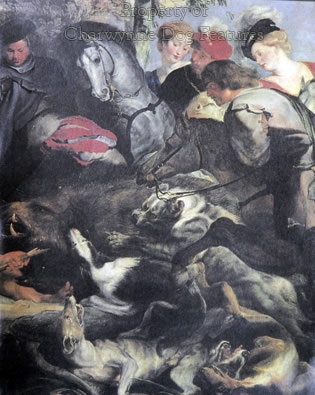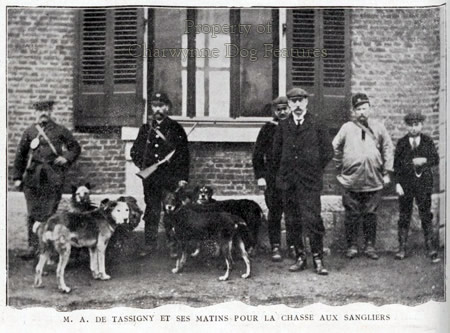872 THE LONG HISTORY OF THE LURCHER
THE LONG HISTORY OF THE LURCHER
by David Hancock
 Today's breed-loving dog-owners tend to disparage the lowly lurcher, mainly because it's not purebred (and in class-conscious countries this seems to matter) but also because it was traditionally the dog of the peasant class. The fact that the latter went for performance ahead of looks and knew the penalties of in-breeding (as the royal families of more than one country exemplify) seems not to matter. Dog historians, and breed historians especially, usually play down the fact that originally all hunting dogs were, by definition, lurchers but are beginning to realise, at long last, the perils of a closed gene pool. Lu
Today's breed-loving dog-owners tend to disparage the lowly lurcher, mainly because it's not purebred (and in class-conscious countries this seems to matter) but also because it was traditionally the dog of the peasant class. The fact that the latter went for performance ahead of looks and knew the penalties of in-breeding (as the royal families of more than one country exemplify) seems not to matter. Dog historians, and breed historians especially, usually play down the fact that originally all hunting dogs were, by definition, lurchers but are beginning to realise, at long last, the perils of a closed gene pool. Lu rchers are the oldest type of domesticated dog on the planet and the lack of literature on them reflects the high priority given to pure breeding by the nobility, who, especially in England, sought sporting breeds, unlike say France, where crossbred hounds, the batards, were prized. Because lurchers cannot be subject to a Breed Standard setting out precise data on appearance and therefore defy classification, they have as a type been seriously undervalued. But then the value of cross-breeding has been under-rated for nearly two centuries.
rchers are the oldest type of domesticated dog on the planet and the lack of literature on them reflects the high priority given to pure breeding by the nobility, who, especially in England, sought sporting breeds, unlike say France, where crossbred hounds, the batards, were prized. Because lurchers cannot be subject to a Breed Standard setting out precise data on appearance and therefore defy classification, they have as a type been seriously undervalued. But then the value of cross-breeding has been under-rated for nearly two centuries.
George Cupples in his Scotch Deer-hounds and Their Masters, Blackwood and Sons, 1894, a must-rea d for sight-hound devotees, wrote:
d for sight-hound devotees, wrote:
“Breeding ‘in-and-in’ – a practice which the deerhound has proved singularly capable of without immediate detriment – took place to an extent that brought back with multiplied force the old complaints of infertility, degeneracy, and ‘distemper’ of the most inveterate type. To this latter ailment some kennels were particularly subject (such as the Duke of Leeds’s, and afterwards, as we have been especially told, Lord Dalhousie’s at Invermark). All were notorious for it, although the fact seemed chiefly to come out in detached specimens that were obtained elsewhere, while the disease was almost unknown in forests where the cross-breeds prevailed.” Unlike our nobility, the French knew the value of Anglo-French scenthounds and their briquets or 'reduced' versions of accepted types of hounds. In western Europe too the coarsely-bred dogs of the hunt, or matins, had their value in taking on the more dangerous roles in the stag and boar-hunt, so that the more prized scent-hounds or par force hounds were not sacrificed.
The matins were big and strong, eventually becoming cart-dogs in many European countries, but without breed-status and as stag and boar-hunting lessened, only a few were kept on in the hunting field. In the early 1900s, a few French hunters maintained 'matin-packs' for use in the boar-hunt; we would have called them boar-lurchers. Some Mastiff breed historians have tried to link the word 'matin' with the origin of the word 'mastiff' but once they realised the mongrel nature of the matins, changed their minds. The reverence for pure breeding is understandable for show ring needs where conformity is essential for breed status, but in the sporting field, performance in the end has to triumph. Breeders of pack-hounds have long resorted to the importation of outside blood, such as French hound-blood, Welsh and American lines and drafts from unrelated stock to maintain performance in the field. Gundogs men however have long championed breeds, now favouring foreign ones as much as our own. 
Modern quarry here led to our lurcher being more often a collie-greyhound mix but in America and Australia their 'staghounds' are usually Deerhound-based. In America and in New Zealand their boar-hunters use a combination of Bulldog-type 'matins'.
In his British Dogs of 1945, Croxton Smith writes:
“…one of the chief auxiliaries of the poacher is that clever rascal, the Lurcher, a compound of Sheepdog and Greyhound, with the brains of one and the speed of the other. Many imagine that the term Lurcher is of comparatively modern derivation. It is a s old as Queen Anne, and no doubt was in use before that queen. ‘He who keeps Greyhounds, Lurchers, Setting-Dogs, to kill the game, being not qualified, forfeits £5, a Moiety to the Informer, the other to the poor.’ So runs a statute of Queen Anne. If it were not for his disreputable associations the Lurcher might very well become a favourite companion on account of his cleverness and teachability.” These 'disreputable associations' more often than not referred to peasant-hunters desperately striving to fill the family pot!
s old as Queen Anne, and no doubt was in use before that queen. ‘He who keeps Greyhounds, Lurchers, Setting-Dogs, to kill the game, being not qualified, forfeits £5, a Moiety to the Informer, the other to the poor.’ So runs a statute of Queen Anne. If it were not for his disreputable associations the Lurcher might very well become a favourite companion on account of his cleverness and teachability.” These 'disreputable associations' more often than not referred to peasant-hunters desperately striving to fill the family pot!
Dogs used in the field are most often the types less altered by show ring whim, although the Breed Standards of the sporting breeds take pains to stress their sporting past - before ignoring it! Old depictions of lurchers could be mistaken for dogs of today, so little have these performance-driven hybrids changed, unlike so many modern former sporting breeds. The dogs portrayed in 19th century prints are not very different from Heywood Hardy's depiction of 1926. The ancient history of the boar-lurcher is shown by its inclusion in the 18th century Linnaean catalogue of 1782, where they are classified as Canis laniarius fuillus. There is nothing new about our long-established lurchers and, metaphorically and literally, they will outlive quite a number of KC-registered breeds.